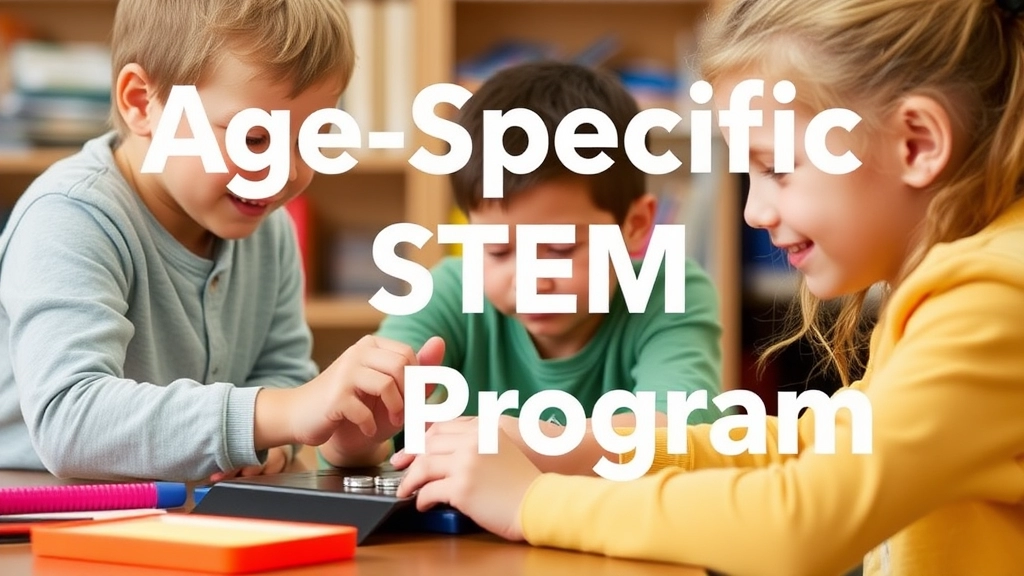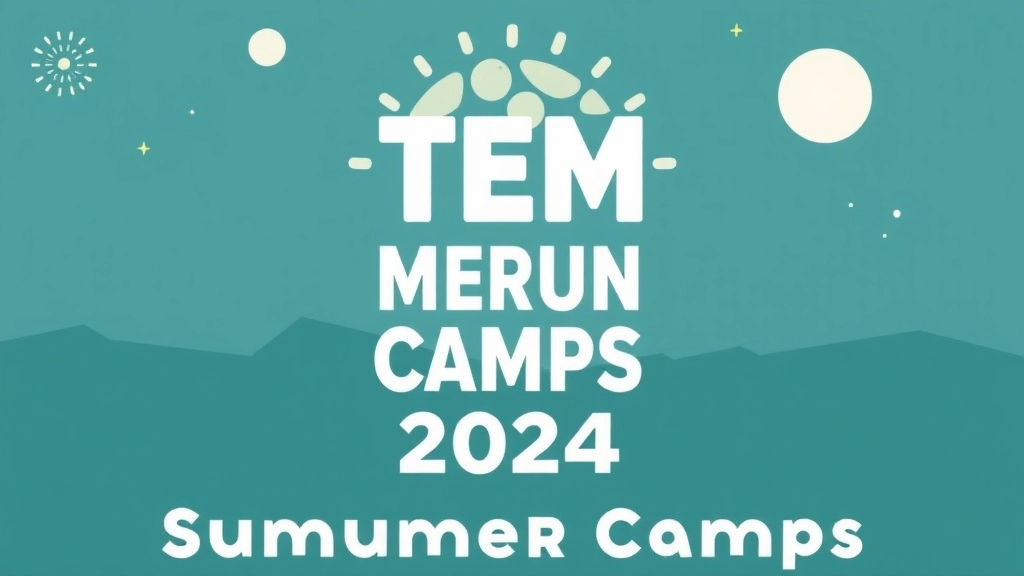STEM Summer Camps 2024
Are you ready to give your child an unforgettable summer filled with learning and fun? Look no further than STEM Summer Camps 2024! This article will guide you through the top STEM camps, highlight the key benefits of attending, and provide tips on choosing the right camp for your child. Whether you’re considering virtual or in-person options, we’ve got you covered.
From age-specific programs to scholarships and financial aid, we’ll break down everything you need to know to prepare your child for a successful STEM camp experience. Plus, you’ll hear inspiring success stories from past campers that will motivate you to take the plunge. Dive in and discover how STEM Summer Camps 2024 can be a game-changer for your child’s future!
Top STEM Summer Camps for 2024
Are you scratching your head trying to find the best STEM summer camps for 2024? You’re not alone. Every parent wants to give their kid an edge, and a solid STEM camp can be a game-changer. Let’s dive into the top picks for this year, so you can stop stressing and start planning.
Why STEM Camps Matter
First off, why even bother with a STEM camp? Simple. They offer a unique blend of fun and education that traditional schools often miss. Kids get hands-on experience in science, technology, engineering, and maths. Plus, they get to meet like-minded peers who share their interests.
Top STEM Camps to Consider
iD Tech Camps
- Location: Various locations across the UK
- Age Range: 7-17 years
- Focus Areas: Coding, game design, robotics, and AI
- Why It’s Awesome: These camps are held at prestigious universities and offer small class sizes for personalised learning.
Camp Invention
- Location: Nationwide
- Age Range: Primary school students
- Focus Areas: Creativity, problem-solving, and hands-on STEM activities
- Why It’s Awesome: Run by the National Inventors Hall of Fame, this camp encourages kids to think outside the box.
Tech Explorers Club
- Location: London
- Age Range: 10-15 years
- Focus Areas: Robotics, coding, and electronics
- Why It’s Awesome: Offers a mix of in-person and virtual options, making it versatile for different needs.
Engineering For Kids
- Location: Multiple locations
- Age Range: 4-14 years
- Focus Areas: Engineering concepts, from aerospace to civil engineering
- Why It’s Awesome: Tailored programmes that grow with your child’s interests and skills.
Mad Science Camps
- Location: Various locations
- Age Range: 5-12 years
- Focus Areas: Fun, interactive science experiments
- Why It’s Awesome: Perfect for younger kids who are just starting to explore their STEM interests.
What Makes These Camps Stand Out?
- Expert Instructors: Most camps employ professionals who are experts in their fields.
- Hands-On Experience: Kids get to build, code, and experiment, not just sit through lectures.
- Networking: Your child will meet peers and mentors who could become lifelong connections.
How to Choose the Right Camp
- Interests and Skills: Match the camp’s focus areas with your child’s interests.
- Location and Convenience: Consider proximity and whether you prefer in-person or virtual options.
- Budget: Look into scholarships and financial aid options (more on that in Section VI).
Real Stories, Real Impact
I remember chatting with a parent whose daughter attended iD Tech Camps. She went from zero coding knowledge to creating her own game in just one summer. That’s the kind of transformation we’re talking about here.
If you’re interested in exploring more options, check out our comprehensive guide on Top STEM Summer Camps for Kids.
Key Benefits of Attending STEM Camps

Wondering if a STEM camp is the right fit for your child?
Let’s break down the key benefits of attending STEM camps.
Real-World Skills
STEM camps aren’t just about learning math and science.
They teach real-world skills that kids can use in everyday life.
Think critical thinking, problem-solving, and teamwork.
Hands-On Learning
Kids learn best when they’re engaged.
STEM camps offer hands-on learning experiences.
They get to build robots, code apps, and even conduct experiments.
Boosts Confidence
Ever seen a kid’s face light up when they solve a tough problem?
That’s what happens at STEM camps.
Boosting confidence is a huge benefit.
Kids tackle challenges and see their own progress.
Networking Opportunities
STEM camps bring together like-minded kids.
They get to network and make friends who share their interests.
These connections can last a lifetime.
Early Exposure to Career Paths
Kids get a taste of what careers in STEM fields are like.
Early exposure helps them decide if they want to pursue it further.
Fun and Engaging
Let’s not forget the fun factor.
STEM camps are designed to be engaging and enjoyable.
Kids have a blast while learning.
Encourages Creativity
STEM isn’t just about logic and numbers.
It’s also about creativity.
Kids get to think outside the box and come up with innovative solutions.
Keeps Kids Active
Forget about sitting in front of a screen all day.
STEM camps keep kids active and engaged.
They’re constantly moving, thinking, and doing.
Prepares for Future Academics
STEM camps can give kids a head start in school.
They’ll be better prepared for future academic challenges.
Parental Peace of Mind
Finally, let’s talk about you.
Knowing your child is learning, growing, and having fun gives you peace of mind.
How to Choose the Right STEM Camp
Are you wondering how to pick the perfect STEM camp for your child? I get it. It’s a big decision. You want them to learn, have fun, and maybe even spark a lifelong passion. So, let’s break it down.
Real Concerns Parents Face
- Will it be worth the investment?
- Is my child old enough?
- Should it be virtual or in-person?
These are real questions, and you’re not alone in asking them. Let’s dive into what matters most.
Key Factors to Consider
- Interests and Goals
- What does your child love? Robotics, coding, or maybe chemistry? Match the camp’s focus with their interests. Consider exploring top engineering summer camps for teens to find the right fit.
- What are their goals? Are they looking to explore or deepen their knowledge?
- Camp Reputation
- Research reviews and testimonials. Past camper success stories can give you insights.
- Check the camp’s track record. How long have they been running? What’s their success rate?
- Age Appropriateness
- Camps often have age-specific programs. Make sure the curriculum fits your child’s age and skill level.
- Location and Format
- Virtual vs. In-Person: Decide based on your child’s comfort and convenience. Virtual camps offer flexibility, while in-person camps provide hands-on experiences.
- Proximity: If opting for in-person, consider travel time and logistics. You might want to check out some top summer camps for teens that offer a variety of formats.
- Cost and Financial Aid
- Budget: Know the costs upfront. Some camps offer scholarships or financial aid, so explore those options.
Personal Stories and Examples
I remember a friend who sent her son to a robotics camp. He was hesitant at first but came back with a newfound passion and even built a mini robot at home. That’s the kind of impact we’re talking about.
Making the Decision
Here’s a quick checklist to help you decide:
Age-Specific STEM Programs

Wondering if there’s a STEM camp that fits your child’s age and interests?
You’re not alone.
Finding the right age-specific STEM program can be tricky.
But it’s crucial.
You want your child to be engaged, challenged, and learning at their own pace.
Let’s break it down.
Early Years (Ages 5-7)
At this age, kids are curious and full of energy.
STEM camps for young children focus on:
- Hands-on activities: Think LEGO building, basic coding games, and simple science experiments.
- Interactive learning: Storytelling combined with science concepts.
- Play-based exploration: Engaging with nature, simple robotics, and fun math games.
Primary School (Ages 8-11)
Kids here are ready for more structured learning.
STEM camps for primary school kids include:
- Intro to Programming: Basic coding with platforms like Scratch or Blockly.
- Science Projects: More complex experiments that explain everyday phenomena.
- Engineering Challenges: Building bridges, rockets, or simple machines.
Middle School (Ages 12-14)
This is where things get exciting.
STEM camps for middle schoolers dive deeper:
- Advanced Coding: Python, JavaScript, or even game development.
- Robotics: Building and programming robots to complete tasks.
- Science Labs: Hands-on experiments in chemistry, physics, and biology.
High School (Ages 15-18)
Teens are preparing for the future.
STEM camps for high school students are more intensive:
- Professional Coding: Learning languages like Java, C++, or web development.
- Engineering Projects: Real-world applications like renewable energy or robotics competitions.
- Research Opportunities: Working on projects that can be presented at science fairs or competitions.
Choosing the Right Age-Specific STEM Program
Here’s a quick checklist:
- Interest and Engagement: Does the camp offer activities that match your child’s interests?
- Skill Level: Is the program challenging but not overwhelming?
- Future Goals: Does it align with your child’s future academic or career aspirations?
Stories from the Field
I remember a parent telling me about their 10-year-old who loved building things.
They signed him up for a camp focused on engineering challenges.
By the end of the summer, he built a working model of a suspension bridge.
He was hooked.
The right age-specific program can ignite a passion.
Virtual vs. In-Person STEM Camps
So, you’re thinking about sending your kid to a STEM camp, but you’re stuck on whether to go virtual or in-person. You’re not alone. This is a common dilemma for many parents, and trust me, it’s worth diving into. Let’s break it down.
The Virtual STEM Camp Experience
Virtual STEM camps have exploded in popularity, especially post-pandemic. But are they any good? Here are some real questions you might be asking:
- “Will my child stay engaged?”
- “Is it just more screen time?”
- “Can they really learn hands-on skills virtually?”
Let’s tackle these one by one.
- Engagement Levels: Many virtual camps have cracked the code on keeping kids engaged. They use interactive platforms, live sessions, and even gamification to keep things lively. Plus, the flexibility of logging in from home can be a big win for both kids and parents.
- Screen Time Concerns: Yes, it’s more screen time, but it’s structured and educational. Unlike endless YouTube spirals, these sessions are focused and goal-oriented.
- Hands-On Learning: Surprisingly, many virtual camps send out kits with all the materials your child will need. Think robotics kits, chemistry sets, and more. So, they get the hands-on experience without leaving the house.
The In-Person STEM Camp Experience
Now, let’s talk about the traditional routeâsending your kid off to an in-person camp. Here are the questions that might be swirling in your head:
- “Is it safe?”
- “Will my child make friends?”
- “Is it worth the cost?”
Let’s break these down too.
- Safety Measures: Most camps have upped their game in terms of health and safety protocols. Think smaller groups, sanitisation stations, and even outdoor classrooms.
- Social Interaction: One of the biggest perks of in-person camps is the social aspect. Kids get to make new friends, work in teams, and develop social skills that are hard to replicate online.
- Cost vs. Value: Yes, in-person camps can be pricier, but they offer a rich, immersive experience. Plus, the memories and friendships can be priceless.
Pros and Cons Table
| Aspect | Virtual STEM Camps | In-Person STEM Camps |
|---|---|---|
| Engagement | High, with interactive platforms | High, with face-to-face interaction |
| Screen Time | Increased, but structured | Minimal, more physical activities |
| Hands-On Learning | Kits sent to home, guided online | Direct, with immediate feedback |
| Safety | Safe at home | Enhanced safety protocols in place |
| Social Interaction | Limited to virtual chats | Rich, face-to-face friendships |
| Cost | Generally lower | Generally higher, but offers immersive experience |
Real Stories
Let me share a quick story. My friend Sarah had her son enrolled in a virtual robotics camp last summer. Initially, she was scepticalâworried about screen time and engagement. But guess what? Her son built a fully functional robot and even won a virtual competition! On the flip side, another friend’s daughter went to an in-person coding camp and came back with a newfound love for programming and a bunch of new friends.
Making the Choice
So, how do you decide? Here are a few tips:
- Assess Your Child’s Needs: If they thrive in social settings, an in-person camp might be the way to go. If they’re more introverted or if you have concerns about health and safety, a virtual camp could be a better fit.
- Check Reviews and Recommendations: Look for testimonials from other parents. Ask around in your community or online forums.
- Budget Considerations: Be realistic about what you can afford, but also weigh the value each type of camp offers.
Scholarships and Financial Aid Options

Worried about the cost of STEM camps? You’re not alone.
Many parents wonder how they’ll afford these opportunities for their kids.
Good news: scholarships and financial aid options are out there.
Let’s break it down.
Why Consider Scholarships?
STEM camps can be pricey, but they’re worth it.
Scholarships can ease that financial burden.
They open doors for kids who might otherwise miss out.
Here’s the scoop:
- Merit-Based Scholarships: For kids who excel academically or show promise in STEM.
- Need-Based Financial Aid: Tailored for families who need a bit of help.
- Organisation-Sponsored Grants: Sometimes companies sponsor budding scientists.
How to Find Them?
Start early.
Seriously, don’t wait.
Here’s a quick list to get you going:
- Camp Websites: Check their financial aid sections.
- Local Community Centres: They often have leads on local scholarships.
- STEM Organisations: Groups like STEM Learning UK often have resources.
Insider Tips
- Apply to Multiple: Don’t put all your eggs in one basket.
- Show Passion: Make sure your kid’s application shows genuine interest.
- Meet Deadlines: Late applications don’t get funded.
Real Stories
I remember chatting with a parent who was sceptical about applying.
They thought, “Why bother? We’ll never get it.”
But they did.
And their child had an unforgettable summer.
Bottom Line:
Scholarships and financial aid can make STEM camps accessible for everyone.
Don’t let cost hold your child back from an amazing opportunity.
Get out there and explore those options.
Tips for Preparing Your Child for STEM Camp
Are you worried about sending your child to a STEM camp? Wondering if they’ll fit in or how to get them ready? You’re not alone. Let’s break it down.
Why Prepare for STEM Camp?
STEM camp can be a game-changer for your child. But how do you make sure they’re ready to dive in and make the most of it?
Get Them Excited
Start by building excitement. Talk to your child about what they’ll learn and the fun they’ll have. Show them videos or testimonials from past campers. It’s all about making it real for them.
Essential Packing List
Preparation isn’t just mental; it’s physical too. Here’s what they’ll need:
- Comfortable Clothing: Think layers. STEM camps can be indoors or outdoors. Check out our gear and clothing essentials for more tips.
- Tech Gear: If the camp requires a laptop or tablet, make sure it’s ready to go.
- Notebook and Pens: For jotting down those brilliant ideas.
- Personal Items: Don’t forget toiletries and any necessary medications.
Encourage Curiosity
Before camp, spark their curiosity:
- Visit Museums: Science museums can ignite interest. Discover more about summer camp fun at natural history museums.
- Watch Documentaries: Choose topics they’re curious about.
- DIY Projects: Simple home experiments can boost confidence.
Social Skills Matter
Help them brush up on social skills. Meeting new people can be daunting, but remind them everyone’s in the same boat. Role-play introductions or practice conversation starters.
Tech Talk
If the camp involves coding or robotics, a little pre-camp practice can go a long way. Websites like Khan Academy or Code.org offer free resources to get started.
Addressing Concerns
Your child might have worries. Will they make friends? What if they don’t understand something? Be there to listen and reassure them. Share stories from other kids who felt the same but ended up loving the experience.
Stay Connected
If it’s an overnight camp, plan how you’ll stay in touch. A quick text or phone call can ease homesickness. But also encourage them to immerse themselves fully in the experience.
Success Stories from Past Campers
Ever wondered if sending your kid to a STEM camp is worth it?
Let me tell you, it absolutely is.
I’ve seen it firsthand.
Meet Sarah, the Robotics Whizz
Sarah was just 12 when she attended her first STEM camp.
She was shy, unsure, and didn’t think she had what it took to excel in robotics.
But guess what?
By the end of the camp, she built a robot from scratch.
She even won the camp’s robotics competition.
Now, she’s leading her school’s robotics team and has her sights set on MIT.
Then there’s Jake, the Coding Prodigy
Jake was always into video games.
His parents thought, why not channel that interest into something productive?
They signed him up for a coding camp.
Jake went from knowing nothing about coding to creating his own game by the end of the summer.
He’s now working on a startup idea with his friends.
How About Emily, the Future Scientist?
Emily was fascinated by space.
She attended a STEM camp focused on astronomy.
She got to use telescopes, learn from real scientists, and even visit a planetarium.
Now, she’s determined to become an astrophysicist.
She’s already acing her science classes and taking part in science fairs.
Why These Stories Matter
These aren’t just feel-good tales.
They’re real examples of how STEM camps can change lives.
Your child could be the next Sarah, Jake, or Emily.
What’s the Common Thread?
- Confidence Boost: Kids come out more confident.
- Real Skills: They gain practical, hands-on experience.
- New Friends: They meet like-minded peers.
- Future Ready: They get a head start on their careers.
Still on the Fence?
Think about it.
Wouldn’t it be amazing to see your child discover their passion?
To watch them grow and excel?
STEM camps make that happen.
So, if you’re considering it, take the plunge. Your child’s success story could be next.
For more information, check out our top cheerleading summer camps in the USA and explore the best summer camps in Seattle for kids.
FAQs on STEM Summer Camps 2024
What are the key benefits of attending STEM camps?
STEM camps provide numerous benefits, including teaching real-world skills like critical thinking, problem-solving, and teamwork. They offer hands-on learning experiences, boost confidence, provide networking opportunities, and give early exposure to career paths. Additionally, they are fun and engaging, encourage creativity, keep kids active, and prepare them for future academics. Parents also gain peace of mind knowing their child is learning and growing in a productive environment.
Are there age-specific STEM programs available?
Yes, STEM camps offer age-specific programs to ensure that children are engaged and learning at their own pace. Programs are available for early years (ages 5-7), primary school (ages 8-11), middle school (ages 12-14), and high school (ages 15-18). Each age group has tailored activities and challenges suitable for their developmental stage.
What activities are included in STEM camps for young children (ages 5-7)?
STEM camps for young children focus on hands-on activities such as LEGO building, basic coding games, and simple science experiments. They also include interactive learning through storytelling combined with science concepts and play-based exploration like engaging with nature and simple robotics.
What can primary school kids (ages 8-11) expect at STEM camps?
Primary school kids can expect activities like basic coding with platforms like Scratch or Blockly, more complex science projects that explain everyday phenomena, and engineering challenges such as building bridges, rockets, or simple machines.
What do middle schoolers (ages 12-14) do at STEM camps?
Middle schoolers dive deeper into advanced coding (Python, JavaScript, or game development), robotics (building and programming robots), and hands-on experiments in chemistry, physics, and biology.
What are the activities for high school students (ages 15-18) in STEM camps?
High school students engage in more intensive activities like learning professional coding languages (Java, C++, or web development), working on real-world engineering projects (renewable energy or robotics competitions), and participating in research opportunities that can be presented at science fairs or competitions.
How do I choose the right age-specific STEM program for my child?
Consider your child’s interests and engagement, the skill level of the program (challenging but not overwhelming), and whether it aligns with their future academic or career aspirations. Finding the right fit can ignite a passion in your child.
Are there scholarships and financial aid options for STEM camps?
Yes, there are scholarships and financial aid options available to make STEM camps more accessible. These include merit-based scholarships for academically excelling kids, need-based financial aid for families requiring assistance, and organization-sponsored grants.
How can I find scholarships for STEM camps?
Start early and explore multiple sources. Check camp websites for financial aid sections, consult local community centers for leads on local scholarships, and look into STEM organizations like STEM Learning UK. Applying to multiple scholarships increases your chances of success.
What tips can help increase the chances of getting a scholarship?
Apply to multiple scholarships, ensure your child’s application shows genuine interest, and meet all deadlines. Passion and timely submissions can significantly enhance your chances of receiving financial aid.
Are there real success stories of families receiving scholarships for STEM camps?
Yes, many families have successfully received scholarships, enabling their children to attend STEM camps. One parent was initially skeptical but ended up securing a scholarship, providing their child with an unforgettable summer experience.
What is the bottom line regarding scholarships and financial aid for STEM camps?
Scholarships and financial aid can make STEM camps accessible for everyone. Don’t let cost hold your child back from an amazing opportunity. Explore all available options to ensure your child can benefit from these enriching experiences.
References
-
STEM Learning UK – Resources and Support for STEM Education
-
Scratch – Imagine, Program, Share
-
LEGO Boost – Building and Coding for Kids

